
 |
|||
| Sponsors websites: | |||
Kidsafe plants for playgroundsBy Todd Layt
Kids love to play, so why not make it safe. There are lots of plants that are safe, but just as many are likely to scratch, poison, or poke them in the eye. Many that may be kid Safe cannot cope with the wear and pressure put on them by kids at play. At the same time kids live for good things, including saving the planet. So if they had a choice, they would more than likely choose plants that are good for the environment. Plants that need no or very little water; ones that use less fertiliser; and best of all plants that change carbon into good air. Hey they all pretty much are good for the air, so there is one box ticked by planting any plant. Landscape Architects specialising in playgrounds use tens of thousands of Tanika. This fine leaf Lomandra is often their favourite, because it is soft and non scratchy, which cannot be said for most Lomandra plants. It requires very little fertiliser, and is one of the most drought tolerant ornamental plants on the planet. It also has proven to work in playgrounds and stand up to the abuse of kids. Once established, it is basically kid proof. But here is the but; even a plant as tough as Tanika needs to establish first. 140mm pots have often proven to be too small to cope with the instant wear and tear of kids, but 200mm pots or larger have proven to perform much better in these situations; the larger the better. If I were designing a playground I would advise the client to pre-order larger plants, if possible 6 months before needing them, so the grower can have them as large as possible at the time of planting. Once established Tanika's year round evergreen foliage gives kids the green plants their minds crave. If you are looking for something bigger try Katie Belles, a Lomandra Hystrix with amazing soft flowers, and its beautiful spring and autumn perfume smell. Its flowers are far less scratchy than the common form, but although it's spent flowers should not bother people, they are stiffer than say Tanika spent flowers. The other popular plants amongst Landscape Architects for kid’s playgrounds are Little Jess and King Alfred, two of the best, toughest Dianella plants available. Both love hot dry or hot humid environments, so they work well in most parts of NSW. Little Jess also makes a good robust border plant. These two do get Purple Berries, which Aboriginal used to eat, with most people not being affected, but I guess there is always a chance for some kid to be allergic to them, so please keep this in mind. These are caerulea types and are generally regarded as safe, where as Dianella tasmanica types can produce berries that can make people a little sick. Avoid these for playgrounds. Often the areas are really shady, so this is where the Liriope excels. Just Right will give you a bigger clump and will stay far more evergreen than Evergreen Giant. Just Right also rarely produces a seed, in fact very rarely, so it is a safer choice around kids than say evergreen giant which is known to produce a lot of berries. Isabella, with its extensive Rhizomes is the best choice as the ground cover form, but it is not big enough to cope with constant abuse like the larger Just Right, so put Isabella where less destruction is happening. Hedging plants are often difficult to keep alive in a kid’s playground. They need to not only survive the kids, but they need to remain with a tidy look. Westringia Naringa stands out as the best hedge for sunny to lightly shaded areas. Tidy, fast enough growing to cope with kids, but it is a tidy hedge form. It also seems non scratchy. A hedge for a shady garden is probably the hardest plant to find. Often space is tight so a thin hedge is needed. Pinnacle, a thin growing Lilly Pilly fits the bill perfectly. It is very narrow, so bigger 200mm or 300mm pots need to be planted close together. Where possible always use 200mm pots or larger for a kids playgrounds, unless a ground cover like Isabella is needed, as these rarely come in pots larger than 140mm. Now you have your basic tough plants to fill 80% of the garden, it’s time to find some plants that have amazing foliage colours or bold flowers. Semi-compact Phormiums such as Flamin’ are good, being soft on the side of the leaf, and stylish, providing red tonnes to the gardens, yet large enough to cope with kids. Flamin’ is also proving to be the toughest variety of Phormium for Sydney, better handling the humidity. However all the robust Phormium types have a spikeier tip than say Lomandra Tanika, so they could have the potential to poke a kid in the eye, if the circumstances were right. Most Cordylines seem similar, but one new one called Sunrise seems to have softer more flexible tips making it a safer choice. This is a vivid reddish pink form; which also seems to burn less in the sun, and works well in moderate shade. As far as silver foliage plants go, the safest and best is Pennstripe. The only variegated ornamental native grass. It can be a real feature of the garden, but the only drawback is that it will need pruning once per year in late winter or early spring, apart from that, in full sun to light shade it is the perfect contrast plant for a kid’s garden, being tougher than the kids who will play near it. When it comes to flowering annuals or perennials, just make sure they are not spiky, and not toxic. If you are using only 20% of the garden for weaker flowering plants, or foliage colour plants, it is not too much of a strain on environmental resources. Watering 20% of the garden is easier, and replanting a small area is not a big task. Some clients may want the extra flair this approach offers, where others simply want plants that will usually live, preferring to stick to tougher plants. Finally, which lawn to choose? A safe one for kids is Palmetto, as unlike most other Buffalo types, it produces very little seed head, meaning it does not cause allergies. It’s also one of the softest to the touch. If the area is shady, Sapphire has proven in research to be the most shade tolerant, but anything above 50% shade with kids wearing it may not be able to cope, even Sapphire. Sometimes there is no choice but to relent and use the far less environmental option of plastic grass, particularly for small excessively worn areas in shade. Avoid plastic grass in full sun as it gets way too hot in summer, as does mulch. On a 40 degree day I tested a playground and recorded the following temperatures. The Plastic grass was 66.95°c, while real turf was 45.65°c. Fine grade wood mulch was 64.15°c in the full sun. The plastic playground equipment was 70.25°c, and surprisingly the metal play ground equipment was 62.35°c; either way a little too hot for kids to play on when it is a 40° day. Shade certainly reduced the heat of a playground. For example the shade of a tree reduced the temperature of the concrete by 25°c. In full sun to keep the surrounds cool try Empire turf as it has incredible wear tolerance. It has vigorous underground rhizomes which will reshoot if damaged, although not as fast as Kikuyu. Sometimes in full sun, the reshoot ability of some of the new faster growing Kikuyu types is the answer. A lot of mowing, but it will work. Kenda for example has an extreme amount of rhizomes; great for wear but not good around gardens for maintenance. So choosing the right turf for the right conditions is important. Consider carefully. When deciding on what type of plant or turf to use around playgrounds, think hard, use larger plants sizes, and have at least the majority of plants you use not only kid safe, but ones that have been proven to work in many playgrounds, surviving kids, drought and neglect. |
|||||||||
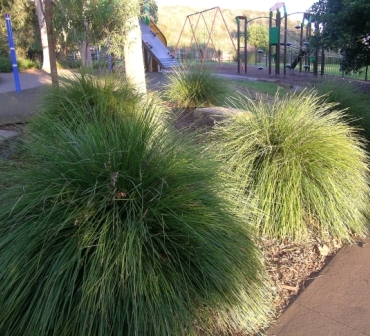 |
|||||||||
| Tanika | |||||||||
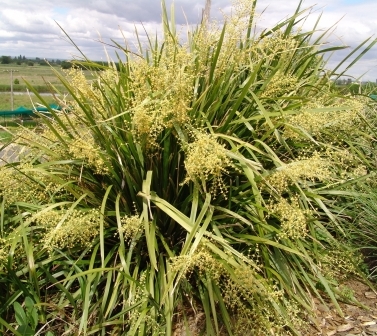 |
|||||||||
| Katie Belles | |||||||||
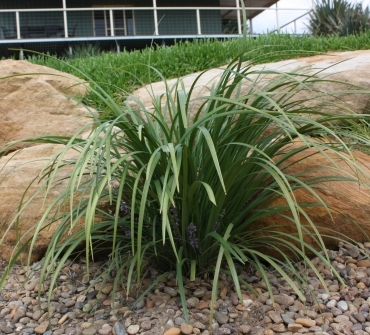 |
|||||||||
| Just Right | |||||||||
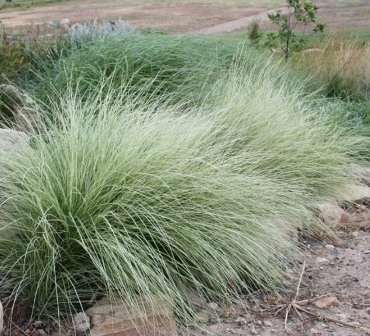 |
|||||||||
| Pennstripe | |||||||||
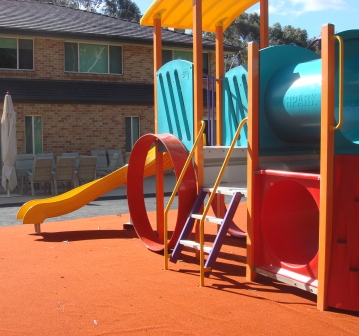 |
|||||||||